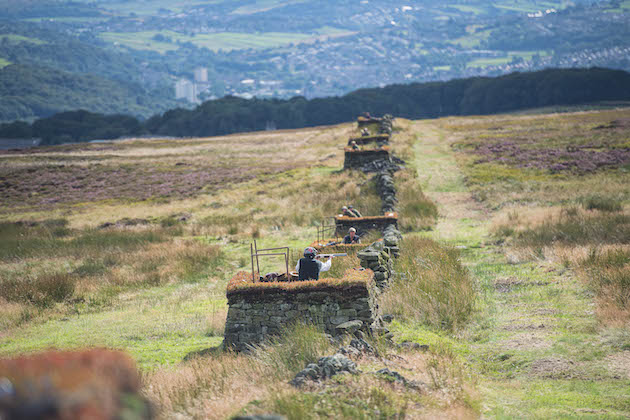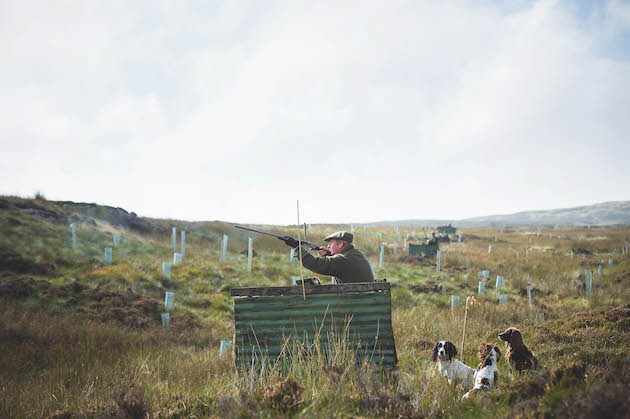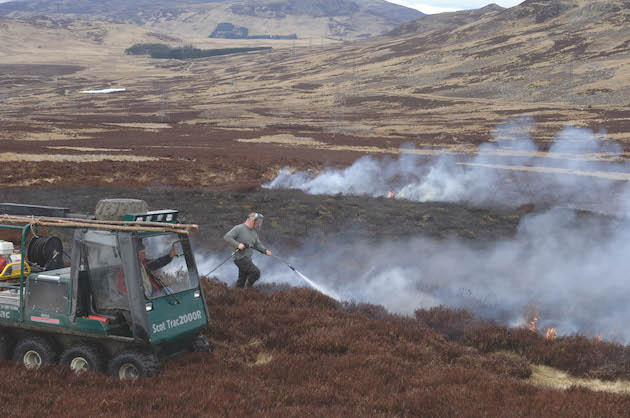Win CENS ProFlex DX5 earplugs worth £1,149 – enter here
Grouse moors: who buys them and are they still a sound investment?
 Harry Consett, Mrs Bromet
Harry Consett, Mrs Bromet
Some 200 years ago, the moorlands of northern England and Scotland were most likely much as they are now. Local farmers would use the inhospitable landscape to graze their sheep and cattle in order to draw a living out of a landscape that would not accept crops and was largely disconnected from the riches of metropolis.
Then, of course, two things changed: the advent of the railways and the invention of the breechloading shotgun. Suddenly, the whistling low-flying grouse became less of a curiosity to passing farmers and transformed into the second most exciting form of shooting after drey poking. A landscape that was largely unfit for human existence became the playground of the nation’s elite. What this meant, in a real estate sense, was that land that was once largely worthless suddenly became extremely valuable.
The estates used to shoot grouse, and the moors contained within, are not small tracts of land. The largest of grouse moors, at some 30,000 acres, is the Raby Estate owned by Henry Vane, 12th Baron Barnard. Others, such as Gunnerside or East Allenheads and Muggleswick, are 26,000 acres.

There are pressures on grouse moor owners but the community is pretty robust
Grouse moors – a small world
What size breeds, as well as decent bags, is scarcity. “It’s a tiny world, the world of grouse moors,” says Jonathan Kennedy, director of CKD Property Advisers. “There are probably around 150 in England and about the same in Scotland.” As such, he says, the number of transactions that occur each year is extremely limited — “maybe one or two” change hands each year, with a “very good” moor hitting the market rarely.
Matthew Watson, rural management director at Savills, agrees, saying: “It’s a rather odd market because there are very few transactions, and a number are part of wider estates, with a few that are standalone assets.” Mr Watson adds that you “wouldn’t expect more than one a year in England to change hands”.
So who buys grouse moors? Well, in the simplest terms, those who are very rich. Priorsdale Moor in Cumbria, which offers just over 4,200 acres of land, has gone under offer, in competition, through CKD at a guide price of some £4.75 million.
As Mr Kennedy points out, these are “life-changing purchases”. “There are always a lot of reasons not to buy a grouse moor, there always have been,” he says. “Historically, they are up and down in terms of performance and you can go years without having a lot to shoot. They are expensive. There are increasing pressures from people who want to stop it. If you’re easily put off, you could be persuaded to just buy a day’s shooting somewhere else, but it’s not the same. There’s never a raft of people queuing up [to buy a moor], but when one comes up there is usually someone for that particular moor at that moment in time. Often it is a self-made individual, who realises life is finite and you need to get on with it. It’s not an investment.”
Grouse shooting — and fieldsports in general — is certainly facing a new peril in recent decades with regards to legislation and public opinion. As Mr Kennedy suggests, there are a lot of people out there who would like to put an end to driven grouse shooting. Information shared on social media, which fuels public perception of grouse shooting as being a sport for tycoons and aristocrats who are thirsty for blood, can make owning a moor uncomfortable. Indeed, websites such as Guy Shrubsole’s Who Owns England have put private owners in the public eye, which might make people think twice about purchasing a moor in future, or might make those who currently own them keen to divest. The fact that moors owned by the National Trust and United Utilities have banned heather burning shows the power of public pressure.
Legislation
Legislation looms too. “Historically, people used to look at grouse moors and value them on a 10-year average,” says Mr Watson. ‘It’s more sophisticated now. If you look at the legislation around management, the changes with heather burning consent, changes on general licensing and if you look north of the border, it’s licensed. It’s changed people’s perception of what they are buying.
“Debates on the future of driven grouse shooting in Parliament don’t instil confidence, do they really,” he adds. “If what you’re buying is entirely shooting focused and the law changes, your asset has changed quite considerably.” Indeed, while the Conservative Party is seen to be the “party of the countryside”, two debates on the future of grouse shooting and heather burning means the issue is unlikely to go away any time soon. It’s “a political hot potato”, adds Mr Watson.
You only need to look at what’s happening north of the border to see the effect of political wind on grouse moors. When I ask Evelyn Channing, rural sales director at Savills in Scotland, what the biggest issue with the market for grouse moors is, her answer is quick and short — the SNP. “We’re slightly ahead of the curve in terms of the pressure facing grouse moors,” she says. “The Werritty Report was conducted by the SNP, and the big outcome was that Professor Werritty said licensing should not be imposed immediately, but it was anyway.”
Ms Channing also describes handling a sale of a moor and estate while the report was being conducted and how it discouraged buyers until the findings of the report were published. “I would suggest it dampened enthusiasm, as people wanted to know what was going to happen,” she adds.

Debates over the future of moorland management, including heather burning, are still going strong
Natural capital
Just as the use of the land changed in the mid-19th century, so too are grouse moors on the precipice of another change. The climate is changing and, as we race to reach ‘net zero carbon’ by 2050, moors, the peat bog underneath them and their potential for forestry means the land used for grouse shooting will start to be valued not only for its birds but for its natural capital too.
“We are perhaps on the cusp of [grouse shooting estates] being repurposed for more climate-efficient purposes,” says Ms Channing, an Mr Watson adds: “What I think we’re seeing is the enthusiasm for buying wild upland land is high. One reason is that you can plant trees, but there’s also the peatland and the carbon. There’s a new demand for these types of assets, which underwrite the asset value, and which gives more confidence to owners that there is an asset value without the sport. There are new revenue streams.”
John Williams, an associate in the rural asset management team at Knight Frank, agrees: “We went to the market at £650,000 for 2,700 acres of moorland in the south-west. It’s in an Area of Outstanding Natural Beauty and contains a Site of Special Scientific Interest. We had a huge amount of interest, both locally and from the green investment funds and multinational companies looking to offset their carbon footprint.
“It’s a whole new side of the market, especially with the Environmental Land Management scheme coming down the line, and carbon sequestration through tree planting and peat. The demand and offers we have received are well above the guide and people are still calling as it’s not technically under offer.”
In the past few weeks alone, there have been damning articles on the efficacy of carbon offsetting abroad used by multinationals, the “planting trees in the rainforest per flight” marketing that we are all getting used to. Might it soon be the case that domestic carbon capture is a far more attractive form of offsetting? And where better than vast peat- filled swathes of northern England and Scotland? After all, while £4.5million might be a lot to you and me, it’s small change for a company such as British Airways.
Sporting asset
The winds might be blowing towards grouse moors being as much an environmental asset as a sporting one but, at the moment, it seems that the love of the sport trumps all, including the hate on social media.
“People are talking about peat being a carbon sink in the future, and that will be a valuable asset. There will be other areas of value within the moor. But people buy grouse moors to shoot grouse,” concludes Mr Kennedy. “There are pressures out there, but the community is pretty robust. Owners complain, but then I try to get them to sell and they won’t do it. They say they love it too much.”
Related Articles
Get the latest news delivered direct to your door
Subscribe to Shooting Times & Country
Discover the ultimate companion for field sports enthusiasts with Shooting Times & Country Magazine, the UK’s leading weekly publication that has been at the forefront of shooting culture since 1882. Subscribers gain access to expert tips, comprehensive gear reviews, seasonal advice and a vibrant community of like-minded shooters.
Save on shop price when you subscribe with weekly issues featuring in-depth articles on gundog training, exclusive member offers and access to the digital back issue library. A Shooting Times & Country subscription is more than a magazine, don’t just read about the countryside; immerse yourself in its most authoritative and engaging publication.







